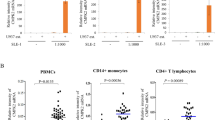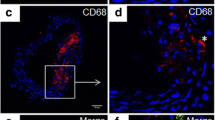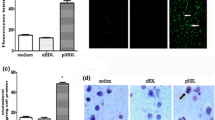Abstract
Purpose
Xanthine oxidase catalyzes the oxidation of xanthine to uric acid. This process generates excessive reactive oxygen species (ROS) that play an important role in atherogenesis. Recent studies show that LRR and PYD domains-containing protein 3 (NLRP3), a component of the inflammasome, may be involved in the formation of foam cells, a hallmark of atherosclerosis. This study was designed to study the role of various scavenger receptors and NLRP3 inflammasome in xanthine oxidase and uric acid-induced foam cell formation.
Methods and Results
Human vascular smooth muscle cells (VSMCs) and THP-1 macrophages were treated with xanthine oxidase or uric acid. Xanthine oxidase treatment (of both VSMCs and THP-1 cells) resulted in foam cell formation in concert with generation of ROS and expression of cluster of differentiation 36 (CD36) and oxidized low density lipoprotein (lectin-like) receptor 1 (LOX-1), but not of scavenger receptor A (SRA). Uric acid treatment resulted in foam cell formation, ROS generation and expression of CD36, but not of LOX-1 or SRA. Further, treatment of cells with xanthine oxidase, but not uric acid, activated NLRP3 and its downstream pro-inflammatory signals- caspase-1, interleukin (IL)-1β and IL-18. Blockade of LOX-1 or NLRP3 inflammasome with specific siRNAs reduced xanthine oxidase-induced foam cell formation, ROS generation and activation of NLRP3 and downstream signals.
Conclusions
Xanthine oxidase induces foam cell formation in large part through activation of LOX-1 - NLRP3 pathway in both VSMCs and THP-1 cells, but uric acid-induced foam cell formation is exclusively through CD36 pathway. Further, LOX-1 activation is upstream of NLRP3 activation.

Steps in the formation of foam cells in response to xanthine oxidase and uric acid.
Xanthine oxidase stimulates LOX-1 expression on the cell membrane of macrophages and vascular smooth muscle cells (VSMCs) and increases generation of ROS, which activate NLRP3 inflammasome and downstream pro-inflammatory mediators such as Caspase-1, IL-1β and IL-18. Xanthine oxidase also induces CD36 expression. Activation of both LOX-1 and CD36 (LOX-1> > CD36) participates in the transformation of macrophages and VSMCs into foam cells. Uric acid formed from xanthine-xanthine oxidase interaction stimulates CD36 expression and triggers foam cell formation independent of NLRP3 activation.






Similar content being viewed by others
References
Kushiyama A, Okubo H, Sakoda H, et al. Xanthine oxidoreductase is involved in macrophage foam cell formation and atherosclerosis development. Arterioscler Thromb Vasc Biol. 2012;32:291–8.
Dawson J, Walters M. Uric acid and xanthine oxidase: future therapeutic targets in the prevention of cardiovascular disease? Br J Clin Pharmacol. 2006;62:633–44.
Chen JH, Lan JL, Cheng CF, et al. Effect of urate-lowering therapy on the risk of cardiovascular disease and all-cause mortality in patients with gout: a case-matched cohort study. J Rheumatol. 2015;42:1694–701.
Hansen OE. Hyperuricemia, gout, and atherosclerosis. Am Heart J. 1966;72:570–2.
Duewell P, Kono H, Rayner KJ, et al. NLRP3 inflammasomes are required for atherogenesis and activated by cholesterol crystals. Nature. 2010;464:1357–61.
Kim SM, Lee SH, Kim YG, et al. Hyperuricemia-induced NLRP3 activation of macrophages contributes to the progression of diabetic nephropathy. Am J Physiol Ren Physiol. 2015;308:F993–1003.
Goyal T, Mitra S, Khaidakov M, et al. Current concepts of the role of oxidized LDL receptors in atherosclerosis. Curr Atheroscler Rep. 2012;14:150–9.
Ding Z, Liu S, Wang X, Mehta JL. LOX-1, mtDNA damage, and NLRP3 inflammasome activation in macrophages: implications in atherogenesis. Cardiovasc Res. 2014;103:619–28.
Ding Z, Liu S, Wang X, et al. Oxidant stress in mitochondrial DNA damage, autophagy and inflammation in atherosclerosis. Sci Rep. 2013;3:1077.
Liu W, Yin Y, Zhou Z, He M, Dai Y. OxLDL-induced IL-1 beta secretion promoting foam cells formation was mainly via CD36 mediated ROS production leading to NLRP3 inflammasome activation. Inflamm Res. 2014;63:33–43.
Ives A, Nomura J, Martinon F, et al. Xanthine oxidoreductase regulates macrophage IL1β secretion upon NLRP3 inflammasome activation. Nat Commun. 2015;6:6555.
Griguer CE, Oliva CR, Kelley EE, et al. Xanthine oxidase-dependent regulation of hypoxia-inducible factor in cancer cells. Cancer Res. 2006;66:2257–63.
Eleftheriadis T, Pissas G, Karioti A, et al. Uric acid induces caspase-1 activation, IL-1β secretion and P2X7 receptor dependent proliferation in primary human lymphocytes. Hippokratia. 2013;17:141–5.
Dai Y, Wang X, Ding Z, Dai D, Mehta JL. DPP-4 inhibitors repress foam cell formation by inhibiting scavenger receptors through protein kinase C pathway. Acta Diabetol. 2014;51:471–8.
Wang X, Khaidakov M, Ding Z, et al. Lectin-like oxidized low-density lipoprotein receptor-1 (LOX-1) and cardiac fibroblast growth. Hypertension. 2012;60:1437–42.
Nomura J, Busso N, Ives A, et al. Xanthine oxidase inhibition by febuxostat attenuates experimental atherosclerosis in mice. Sci Rep. 2014;4:4554.
Schröder K, Vecchione C, Jung O, et al. Xanthine oxidase inhibitor tungsten prevents the development of atherosclerosis in ApoE knockout mice fed a western-type diet. Free Radic Biol Med. 2006;41:1353–60.
Battelli MG, Polito L, Bolognesi A. Xanthine oxidoreductase in atherosclerosis pathogenesis: not only oxidative stress. Atherosclerosis. 2014;237:562–7.
Chellan B, Reardon CA, Getz GS, Hofmann Bowman MA. Enzymatically modified low-density lipoprotein promotes foam cell formation in smooth muscle cells via Macropinocytosis and enhances receptor-mediated uptake of oxidized low-density lipoprotein. Arterioscler Thromb Vasc Biol. 2016;36:1101–13.
Ledda A, González M, Gulfo J, et al. Decreased OxLDL uptake and cholesterol efflux in THP1 cells elicited by cortisol and by cortisone through 11β-hydroxysteroid dehydrogenase type 1. Atherosclerosis. 2016;250:84–94.
Misra MK, Sarwat M, Bhakuni P, Tuteja R, Tuteja N. Oxidative stress and ischemic myocardial syndromes. Med Sci Monit. 2009;15:RA209–19.
Wong HS, Jaumouillé V, Freeman SA, et al. Chemokine signaling enhances CD36 responsiveness toward oxidized low-density lipoproteins and accelerates foam cell formation. Cell Rep. 2016;14:2859–71.
Lin YT, Jian DY, Kwok CF, Ho LT, Juan CC. Visfatin promotes from cell formation by dysregulating CD36, SRA, ABCA1, and ABCG1 expression in RAW264.7 macrophages. Shock. 2016;45:460–8.
Kotla S, Rao GN. Reactive oxygen species (ROS) mediate p300-dependent STAT1 protein interaction with peroxisome proliferator-activated receptor (PPAR)-γ in CD36 protein expression and foam cell formation. J Biol Chem. 2015;290:30306–20.
Chen Y, Kennedy DJ, Ramakrishnan DP, et al. Oxidized LDL-bound CD36 recruits an Na+/K+-ATPase-Lyn complex in macrophages that promotes atherosclerosis. Sci Signal. 2015;8:RA91.
Yang X, Yao H, Chen Y, et al. Inhibition of glutathione production induces macrophage CD36 expression and enhances cellular-oxidized low density lipoprotein (oxLDL) uptake. J Biol Chem. 2015;290:21788–99.
Brown PM, Kennedy DJ, Morton RE, Febbraio M. CD36/SR-B2-TLR2 dependent pathways enhance Porphyromonas gingivalis mediated atherosclerosis in the Ldlr KO mouse model. PLoS One. 2015;10:e0125126.
Mehta JL, Chen J, Hermonat PL, Romeo F, Novelli G. Lectin-like, oxidized low-density lipoprotein receptor-1 (LOX-1): a critical player in the development of atherosclerosis and related disorders. Cardiovasc Res. 2006;69:36–45.
Mehta JL, Sanada N, CP H, et al. Deletion of LOX-1 reduces atherogenesis in LDLR knockout mice fed high cholesterol diet. Circ Res. 2007;100:1634–42.
Author information
Authors and Affiliations
Corresponding authors
Ethics declarations
Funding
This study was supported by funds from National Natural Science Foundation of China (Grant No. 81500344); Anhui Provincial Natural Science Foundation (Grant No.1508085MH178); the National Natural Science Foundation for Fostering Young Scholars of China (the First Affiliated Hospital of Anhui Medical University, Grant No. 2013KJ25), and the Department of Veterans Affairs, Veterans Health Administration, Office of Research and Development, Biomedical Laboratory Research and Development, Washington, DC.
Conflicts of Interest
None.
Research Involving Human Participants and/or Animals
This article does not contain any studies with humans or animals performed by any of the authors.
Informed Consent
Not applicable.
Rights and permissions
About this article
Cite this article
Dai, Y., Cao, Y., Zhang, Z. et al. Xanthine Oxidase Induces Foam Cell Formation through LOX-1 and NLRP3 Activation. Cardiovasc Drugs Ther 31, 19–27 (2017). https://doi.org/10.1007/s10557-016-6706-x
Published:
Issue Date:
DOI: https://doi.org/10.1007/s10557-016-6706-x




